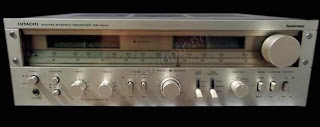Hitachi the
new leader in audio technology introduces the world's most powerful 50 watt
receiver.
The new
SR-804 stereo reciver has the revolutionary Class G amp that instantly doubles
its rated power from 50 to 100 watts to prevent clipping distortion during
those demanding musical peaks (note the clipped and unclipped waves in the
symbolic graph above).
The SR-804
is conservatively rated at 50 watts RMS, 20 - 20,000 Hz into 8 ohms with only
0,1% THD.
Class G is
just one example of Hitachi's leadership in audio technology. Power MOS FET
amplifiers, R&P 3-head system cassette decks, Uni-torque turntable motors,
and gathered-edge metal cone speakers are just some of the others. Ther's a lot
more.
Specifications
Tuner Sections
FM Stereo
Frequency Range: 88 -108 MHz
Usable
Sensitivity (IHF):
Mono : 10,3
dBf (1,8 µV)
Stereo : 20
dBf (5,5µV)
50 dB
Quieting Sensitivity:
Mono : 17
dBf (3,9 µV)
Stereo : 37
dBf (39 µV)
Harmonic
Distortion (at 65 dBf):
100 Hz :
0,2% (Mono); 0,3% (Stereo)
1 kHz :
0,15% (Mono); 0,25% (Stereo)
6 kHz :
0,25% (Mono); 0,3% (Stereo)
Signal-to-Noise
Ratio: 74 dB (Mono); 68 dB (Stereo)
Frequency
Response: 30 Hz - 12 kHz +0,5 dB
Image
Response Ratio: 90 MHz - 56 dB; 98 MHz -
50 dB; 106 MHz - 45 dB
Spurious
Response Ratio: 80 dB
IF Response
Ratio: 80 dB
Alternate
Channel Selectivity: 75 dB
Capture
Ratio: 1 dB
AM
Suppression Ratio: 55 dB
Stereo
Separation: 45 dB (1 kHz)
Sub Carrier
Suppressions: 50 dB
SCA
Rejection: 65 dB
Muting
Thereshold: 20 dBf (5,5 µV)
Antenna
Input: 300 Ω balanced
AM Section
Frequency
Range: 530 - 1605 kHz
Sensitivity: 370 µV/m (S/N 20 dB), 20 µV (IHF ext.
Antenna)
Selectivity
(IHF): 36 dB
Image
Rejection Ratio: 50 dB
IF Rejection
Ratio: 42 dB
S/N
Ratio: 50 dB
Antenna: Ferrite antenna and separate terminal
Audio
Section
Music Power
(IHF):
60
W/ch + 60 W/ch (8 Ω, 1 kHz, 0,1% THD)
65
W/ch + 65 W/ch (4 Ω, 1 kHz, 0,1% THD)
RMS
Power Output (both channel driven): 50
watts per channel, min. RMS, at 8 Ω
from 20 - 20,000 Hz, with no mor than 0,1% THD
Frequency
Characteristics: 10 Hz - 30 kHz (+0 -1
dB); 10 Hz - 40 kHz (+0 -2 dB)
Power
bandwidth: 10 - 40,000 Hz (½ RMS Power, 0,1% THD)
Harmonic
Distortion:
At rated
output : Less than 0,1%
At ½ rated output : Less than 0,05%
Intermodulation
Distortion:
At rated
output : 0,1%
At ½ rated output : 0,05%
Tone
Controls:
Bass : ±10
dB at 100 Hz
Treble : ±10
dB at 10 kHz
Power
Source: 100V/120V/220V/240V 50/60 Hz



This is an amazing receiver. I purchased mine on 8-28-1979 for $360. Not much in preamp controls, just the basics. It does offer bidirectional dubbing with two tape monitors and an aux input. The filters are marginally effective as the slope is too gradual (same with most receivers of that period).
RispondiEliminaThe FM performance is crisp and clean, a high quality FM front end with great sensitivity.
Amplifier performance is awesome, rated at 50wpc it has a headroom rating of 3dB (twice the rated power) which is exceptional. High volumes are achieved effortlessly, with plenty of reserve power. It does have a clinical sound. Clean, clear, articulate. Not a WARM cozy sound. Perfect for the transients in live performances. It weighs less than thirty pounds and runs cool. After eight hours of use the top is barely warm! Mine is almost 39 years old and has only been serviced for lamps and cleaning, and is used almost every day. A remarkable component, no argument. I'm very satisfied, fuhgeddaboudit!!
I concur. I traded my Marantz 2220 for this receiver and I know I have something far superior with this one. The record store owner wanted my Marantz because that name is an easy sell, whereas the Hitachi name usually passes under the radar. It's true that this class G amp sounds cold and clinical compared to the Marantz, yet it outperforms the Marantz in every way. I'm talking about power, loudness, clarity and accuracy. The tuner reception is also far superior. It is also one of the best looking receivers I've ever seen. This amp never gets hot, either.
RispondiEliminaI picked up my Hitachi SR 804 a few months ago. Firstly, I own a Pioneer SX 1080 along with a Marantz 2230. I'm running 4 DCM 704 Tower speakers. The Hitachi outperforms every reciever I own including the aforementioned recievers. It is Rated at 50WPC 0.01% THD and I believe that it pushes much closer to 65WPC. The anti-clipping feature is nothing short of amazing. I can turn my volume knob past 2 o'clock and all ranges come live and in person. Also, this reciever can run 8 hours and it barely gets warm! It will run just about any speaker and come through perfectly. Probably THE most underrated 70's "Silverface" ever produced. No hyperbole, just raw truth!
RispondiElimina